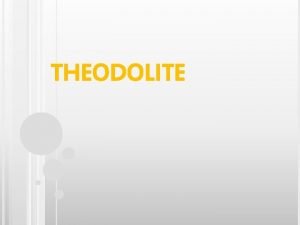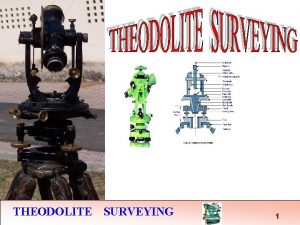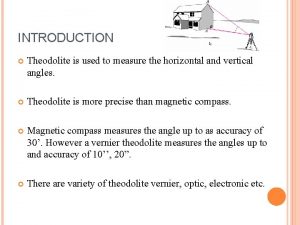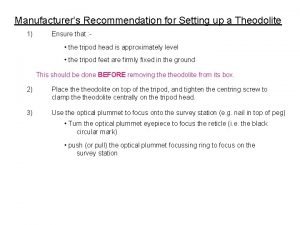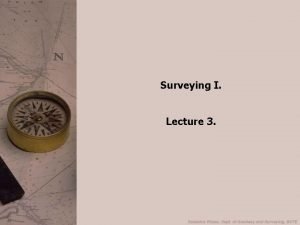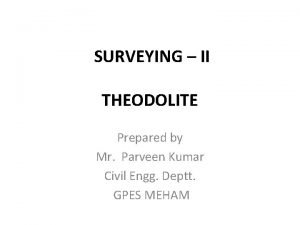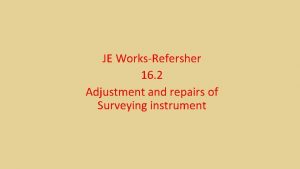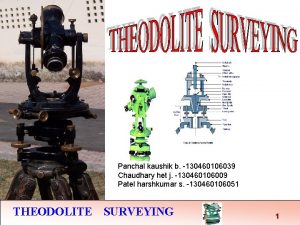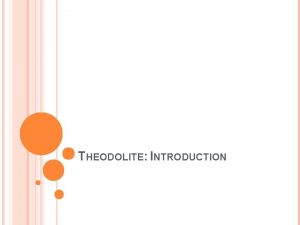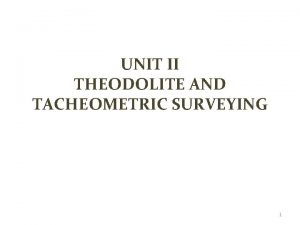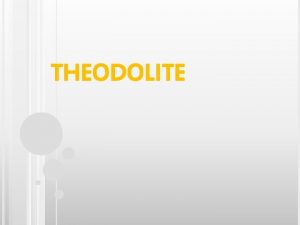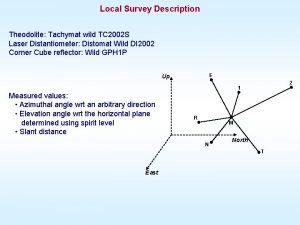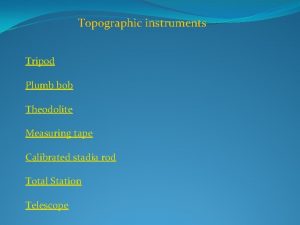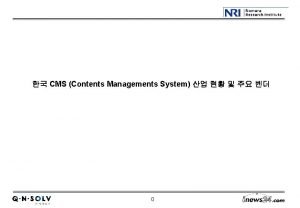THEODOLITE CONTENTS History Of Theodolite v Purpose v




























- Slides: 28

THEODOLITE

ØCONTENTS History Of Theodolite v Purpose v Types And Its Specification v Types Commonly Used In Pakistan v Procedure Of Operation Of Theodolite v

ØWHAT IS THEODOLITE An instrument used in surveying to measure horizontal and vertical angles with a small telescope that can move in the horizontal and vertical planes. Theodolites are electronic devices that are widely used for the measurement of vertical and horizontal angles for mapping applications, and in the construction industry.

ØHISTORY Early history: People have been measuring angles for construction purposes for many centuries. Egyptians used groma, an early version of a theodolite, to help build the pyramids. Furthermore, there also records that indicate that the Romans used tools such as dioptra (circular plate that marked angles), for similar purposes. In 1571, Leonard Digges came up with a device which more closely resembled an early theodolite and called it theodolitus. It was a divided circle and square with a compass in the center, according to "Brief History of Turning Angles" at noaa. gov, but it lacked a telescope (found in modern versions).

ØHISTORY Modern History: The telescope mounted on top of the measuring device came into being by the mid 1700 s. The device also had a horizontal circle with a vertical semi-circle. Early theodolites were woks of art; they were hand made out of brass and the angles were scribed by hand. They did, however, have a significant margin for error because they were only as accurate as the individual who scribed the angles. This is important because an error of one second translated into an error of one foot, at a distance of 40 miles.

ØHISTORY Later history: In 1773, Jesse Ramsden invented a mechanical dividing engine that allowed for higher accuracy and production of theodolites. This, in turn, resulted in an increase of theodolite availability and placed England at the front of theodolite production industry. Theodolites came to the United States in 1815, on the request of Thomas Jefferson. He wanted Ferdinand Hassler, the appointed Superintendent of the Survey of the Coast, to survey America. Theodolites remained pretty much unchanged until the 1950 s when electronic distance measurements were adopted.

ØPUPPOSE OF THEODOLITE A theodolite is a tool for measuring vertical and horizontal angles. It is used in triangulation networks. It looks like a small telescope and is used everywhere from construction sites to highway points. Theodolites measure angles using age old principles of trigonometry and assist surveyors in establishing precise locations. From geometry, we know that it is possible to calculate unknown lengths and angles of a triangle given particular information regarding the other angles and lengths of the sides of a triangle. For example, given beginning coordinates such as (x, y) in plane coordinates or the latitude and longitude, it is then possible to calculate new coordinates by measuring certain angles and distances (lengths of sides of a triangle).

ØPURPOSE OF THEODOLITE Knowing this information, surveyors use triangulation (a technique that creates a series of connected triangles for specific measurements of angles and distances). The connected triangles are then used to establish longitudes and latitude, according to "Angular Point of View" at noaa. gov. In order to get precise measurements, surveyors use theodolites.

ØTYPES AND SPECIFICATION Repeating Theodolite Many angle readings are taken on a graduated scale. The average angle measurement is obtained by dividing the accumulated sum readings by the number of observed readings. The results of these theodolites are good. These instruments are confined for locations where the support is not stable, or space for using other such instruments is limited. Direction Theodolites The circle is arranged to be fixed, while the telescope is aimed on a number of signals. Readings on the circle are read for every direction. Direction theodolites are ideal instruments for triangulation.

ØTYPES AND SPECIFICATION Vernier Theodolite: This is most commonly used. In this type of instrument, observations are taken by using the principle of vernier caliper. The precision of this type of instrument varies in the order of 10" to 20".

ØTYPES AND SPECIFICATION This is a Vernier Theodolite incorporating the famous Stanley solid 'U' frame single casting design, where the support for the horizontal axis is cast in one piece. The instrument therefore features a vernier reading system for the horizontal and vertical circles instead of an optical micrometer system. The circles are equipped with magnifying glasses attached at opposite ends of each circle for more comfortable vernier reading. The instrument consists of: - (1) A leveling base which supports the main working parts of the instrument and is capable of being screwed onto a tripod, (2) A lower circular horizontal metal plate with a silver vernier graduation, (3) An upper circular horizontal plate, (4) A vertical circle with vernier graduations, and (5) A telescope with the altitude bubble attached beside the vertical circle. It is manufactured in 1910 (approx. ).

ØTYPES AND SPECIFICATION Digital theodolite: This type of theodolite provides the value of observation directly in viewing panel. The precision of this type of instrument varies in the order of 1" to 10".

ØTYPES COMMONLY USED IN PAKISTAN Theodolite T-2 Theodolite DKM – 2 A Tehodolite Transit

ØPROCEDURE OF OPERATION OF THEODOLITE Before operating, theodolite needs to be placed directly over the station (so called nail accuracy), and then level it. This has to be done at the same time as described below. (this is better done in practice than describe in words!)

ØPROCEDURE OF OPERATION OF THEODOLITE A. Precise levelling and positioning of theodolite 1. Set tripod and instrument with optical plumb almost over the station. 2. Unclamp one of the horizontal clamp (either will do) and traverse the instrument so that the plate bubble is parallel to two of the footscrews. 3. Adjust those two footscrews until the plate bubble is level. 4. Traverse the instrument so that the bubble is perpendicular to the already adjusted footscrews. 5. Re-level using the third footscrew.

ØPROCEDURE OF OPERATION OF THEODOLITE A. Precise levelling and positioning of theodolite 6. Traverse the instrument in the same direction and re-align parallel to the first two footscrews. 7. Repeat stage 3 and then traverse as in 4. Then repeat stages 5 -7, until the best mean level bubble is obtained (to one division accuracy). 8. Unclamp the base of the instrument and while viewing through optical plumb, slide the instrument across the tripod base until it is exactly over the station. Do not rotate the instrument about the tripod base. (Note that it might be necessary to repeat stages 1 -7!!)

ØPROCEDURE OF OPERATION OF THEODOLITE B. Zeroing the Horizontal circle 1. Unclamp the Upper Horizontal clamp. 2. Traverse the instrument until the horizontal circle reads approximately zero. 3. Re-clamp the Upper Clamp. 4. Adjust the Upper Horizontal Tangent Screw until the reading is approximately zero. 5. Select a target whose direction you wish to assign a zero scale reading. 6. Unclamp the Lower Horizontal clamp.

ØPROCEDURE OF OPERATION OF THEODOLITE B. Zeroing the Horizontal circle 7. Traverse the instrument (and circle) until the telescope is pointing approximately at the selected target. 8. Re-clamp and, sighting through the telescope, align the vertical graticule precisely onto the target using the Lower Horizontal Tangent Screw. It is important that you approach the target in the direction in which you intend to continue to traverse to the next target. This is to minimize errors and is dealt with in more detail later. The instrument is now correctly sighted onto the target and is reading zero. The lower horizontal clamp and lower tangent screw should not be touched again until this particular ‘round’ of readings has been completed.

ØPROCEDURE OF OPERATION OF THEODOLITE C. “FACE” and “SWING” • As defined earlier in the subject, the standard which houses the vertical circle is called the Face of the instrument. If, when sighting through the telescope, this standard (the face) is on your left, then FACE LEFT is recorded for all readings taken. If on the right, then we record FACE RIGHT. • The Swing of the instrument is defined as the direction in which theodolite is traversed (i. e. rotated about vertical axis). If, when traversing, the telescope lens moves to the left we record readings as SWING LEFT. If on the right, we record readings as SWING RIGHT. • Every horizontal circle reading must be booked with the face and swing identified. Usually it is conventional to work with opposite face and swing, i. e. FL/SR and FR/SL

ØPROCEDURE OF OPERATION OF THEODOLITE D. Taking a round of Horizontal readings The following procedure would normally be adopted to measure the horizontal angle subtended at theodolite station T by the two targets A and B. 5. Adjust the lower horizontal tangent screw to complete the swing movement and bring the graticule cross precisely in line with target A. Do not “overshoot”! 6. Read and book the horizontal scale reading (which should be zero). 7. Now unclamp the Upper horizontal clamp. Traverse the instrument to approach target B using the same swing as before, stopping just short of target. Re-tighten (clamp) the upper clamp.

ØPROCEDURE OF OPERATION OF THEODOLITE D. Taking a round of Horizontal readings The following procedure would normally be adopted to measure the horizontal angle subtended at theodolite station T by the two targets A and B. 1. Set Horizontal scale to zero and ensure both clamps are tightened. 2. Select Face (L or R) by transiting the telescope (if necessary). 3. Release the lower horizontal clamp. Traverse the instrument to approach target A using the appropriate Swing direction (L or R) stopping just short of the target. 4. Clamp the lower clamp.

ØPROCEDURE OF OPERATION OF THEODOLITE D. Taking a round of Horizontal readings The following procedure would normally be adopted to measure the horizontal angle subtended at theodolite station T by the two targets A and B. 8. Adjust the upper horizontal tangent screw to complete the swing movement and bring the graticule cross in line with target B. 9. Read and book the horizontal scale reading.

ØPROCEDURE OF OPERATION OF THEODOLITE D. Taking a round of Horizontal readings • Now if we transit the telescope by approximately 180º, this will be facing away from target B. By repeating stages 8 -10 above (opposite swing now), another reading is recorded for target B and then at A (continuing traverse). • This round of readings is now complete and will give us two versions of the same angle. Depending on the nature of the work and the accuracy required we may produce more rounds of readings, using opposite faces and swings or different positions on the horizontal circle producing 4 or even 8 versions of the same angle. • The reason for this systematic approach using different combinations of face, swing and Position on the horizontal circle is to minimize systematic errors.

ØPROCEDURE OF OPERATION OF THEODOLITE E. Booking Horizontal Angle Readings An example, based on the description in D, is given below. Note that face left and face right readings on the same target differ by approximately 180º, if the instrument is in precise adjustment.

ØPROCEDURE OF OPERATION OF THEODOLITE Instrument Target Station (I. S. ) Face/Swing Horiz. Circle (º′″) T T A B L/R 000 -00 -00 136 -34 -20 T T B A R/L 316 -34 -40 180 -00 -10 Reduced Angle (º′″) 136 -34 -20 136 -34 -30

ØPROCEDURE OF OPERATION OF THEODOLITE E. Booking Horizontal Angle Readings • Note that the horizontal scale is always graduated so that readings increase in a clockwise sense. Also, the reduced angle is clockwise from A to B (i. e. reading at B minus reading at A or say RB-RA). • However, consider the case of reducing as RA-RB. This would have represented the clockwise rotation from B to A and the booking should have been as follows.

ØPROCEDURE OF OPERATION OF THEODOLITE Instrument Target Station (I. S. ) Face/Swing Horiz. Circle (º′″) Reduced Angle (º′″) T T A B L/R 360 -00 -00 136 -34 -20 223 -25 -40 T T B A R/L 316 -34 -20 180 -00 -10 223 -25 -30

ØPROCEDURE OF OPERATION OF THEODOLITE E. Booking Horizontal Angle Readings • Both reductions are equally acceptable, but the important question is: which angle has been obtained? It is easy to work out with common sense by visualizing the real situation. This approach is good enough when angles are close to 90º but will not necessarily work for angles close to 180º!
 Theodolite introduction
Theodolite introduction Purpose purpose
Purpose purpose Chapter 5 selecting a topic and a purpose
Chapter 5 selecting a topic and a purpose Temporary adjustment of theodolite
Temporary adjustment of theodolite Reiteration method in surveying
Reiteration method in surveying Horizontal
Horizontal Bubble tube in theodolite
Bubble tube in theodolite Balancing in theodolite
Balancing in theodolite Bubble tube in theodolite
Bubble tube in theodolite Repetition and reiteration method in surveying
Repetition and reiteration method in surveying Temporary and permanent adjustment of theodolite
Temporary and permanent adjustment of theodolite Measurement of horizontal angle by theodolite
Measurement of horizontal angle by theodolite Pathfinder philosophy
Pathfinder philosophy Agdao coop branches
Agdao coop branches History also history physical
History also history physical Introduction of portfolio
Introduction of portfolio Deep perineal pouch contents
Deep perineal pouch contents Fresh frozen plasma contents
Fresh frozen plasma contents Fresh frozen plasma contents
Fresh frozen plasma contents Superior mediastinum contents
Superior mediastinum contents Triangle scarpa
Triangle scarpa Horizontal
Horizontal The immortal life of henrietta lacks table of contents
The immortal life of henrietta lacks table of contents Contents of internal capsule
Contents of internal capsule Triangular space contents
Triangular space contents Ark
Ark So we meet again my dear doctor
So we meet again my dear doctor Porta hepatis
Porta hepatis Mla table of contents
Mla table of contents
